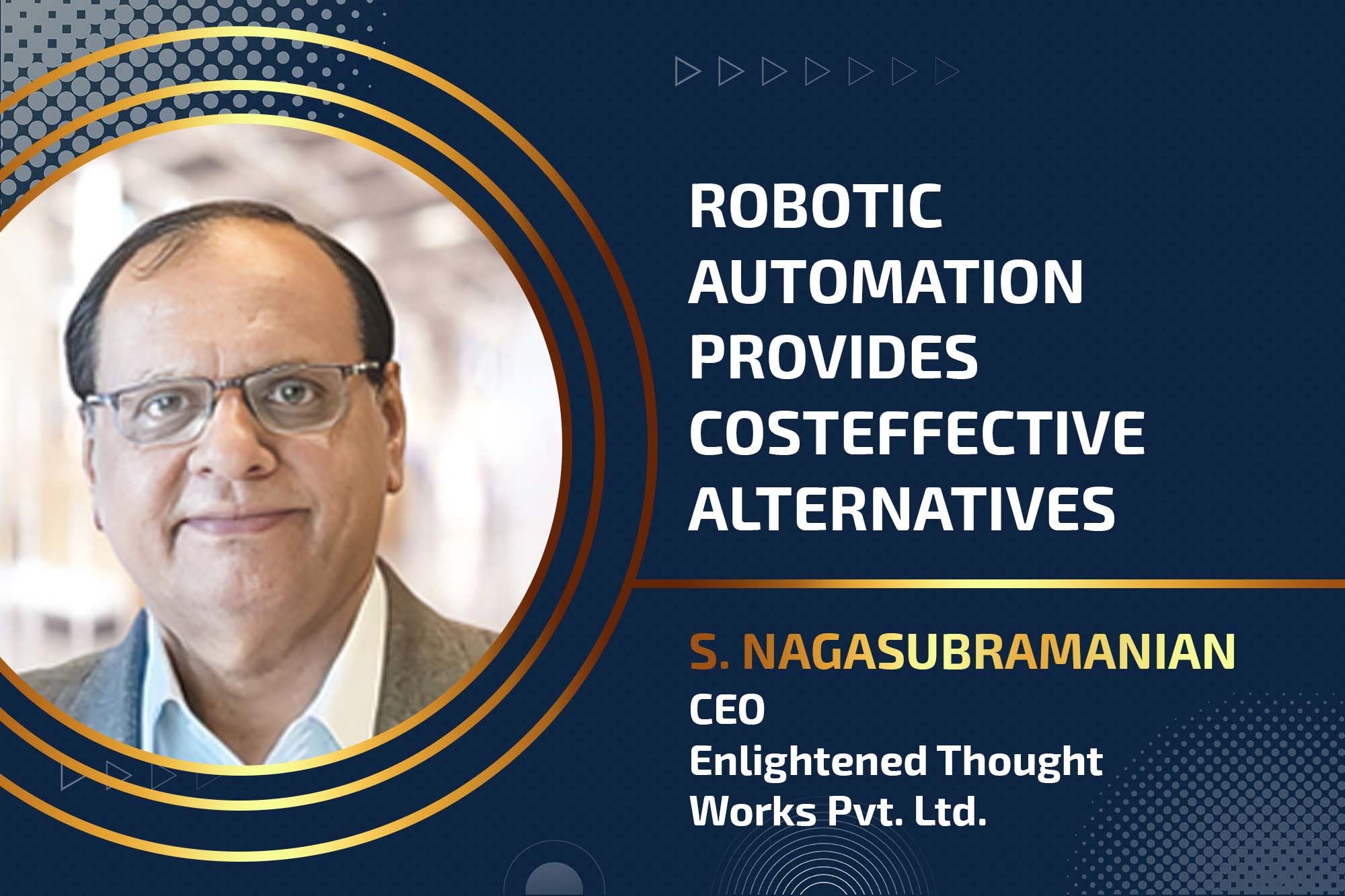Mobile robots use sensing components to detect the environment
By OEM Update Editorial December 2, 2022 3:31 pm IST
We are now entering the third robot wave, where robotic workers operate alongside human and symbiotic workers, equipped with performance-enhancing robotic devices.
Automation and industrial robots
Unlike the automotive and other machinery industries, industrial robotics is “low volume, high complexity.” The low-volume designation is related to the relatively small number of machines that are produced and deployed within each specification. Two realities characterise the high complexity of the industrial robotics sector. First, the breadth of different machine types that can be included under the umbrella is massive, just in the sheer number of machine types. Second, there is also great variety in the size, technology, and application areas of robots. Amid this lack of uniformity or common control systems in the robotics industry, industrial robots are categorised along the lines of physical attributes (reach, weight, etc.), how they interact with humans, their mobility, and their level of autonomy. The largest applications include materials handling operations like machine tending, welding and soldering.
Demand for IoT, AI and robotics integration for manufacturing
Automation is taking place at scale across industries and countries with relevant technologies evolving or coming into existence. And the expectation is for automation to scale worldwide across industries and countries. A recent study has identified significant automation potential across various sectors. Already today, we see that the speed of automation introduction, however, varies between countries. Robots will become critical automation enablers with sizeable economic impact. Some reports estimate that the total market for industrial robotics systems was already USD 60 billion in 2030. The market for industrial robots has been growing at record rates of around 19 percent per annum since 2012/13 and is expected to continue double-digit growth at least through to 2025. Smaller, lower-cost robot applications are in high demand. Finally, the lower cost of producing robots (e.g., through increasing production in lower-cost regions) leads to decreasing prices (a more than 40 percent drop in average robotics costs since 2010).
Managing robotisation for manufacturing and workers’ safety
The initial waves of industrial robots were introduced in the 1970s when they began to be used in the manufacturing sector for assembling automobiles. The second robot wave took off at the turn of the 21st century with the introduction of service robots. It was facilitated by the increasing autonomy and sensory capabilities of robots coupled with decreasing cost and size of microprocessor controllers, which led to the development of mobile robots capable of autonomous operation in unfamiliar environments such as disaster zones (“drones”). With the availability of relatively inexpensive collaborative robots capable of directly contacting people, we are now entering the third robot wave where robotic workers operate alongside human workers and symbiotic workers, i.e., human workers equipped with performance-enhancing robotic devices such as robotic exoskeletons and other capacity-enhancing prostheses. As more robots, especially mobile ones, come into direct contact with workers, concerns about the safety profile of the worker-robot interaction space have increased. Historically, human workers are the first to experience the adverse effects of any new technology. In addition, the duration of human workers’ exposure to new technologies is often greater than that of the general population.
The continuing rise of robotics increases the risks associated with robotic systems’ hazards, such as workers being struck-by, caught between, crushed, and/or trapped. There are also electrical, hydraulic, pneumatic, and environmental hazards. Employers must implement a safeguarding strategy to protect workers in robotic industries using a hierarchy of controls. To protect workers engaged in robotic industries, employers should implement a safeguarding strategy as follows, using a scale of controls:-Elimination – Physically remove the hazard, Substitution – Replace the Hazard, Engineering Control – Isolate people from the work, Admin Control – Change the way the people work, PPE – Protect the worker with Personal Protective Equipment. The Employer also includes the typical requirements for all machinery in workplaces, including Organisational measures (e.g. administrative controls), Safe working procedures, Supervision, Permit-to-work systems Provision and use of additional administrative safeguards, Use of PPE, Training.
Industry 4.0 technology challenges
The market evolves at a pace consistent with the participants’ principal needs: safe, durable technology that helps the real needs of the industry. The market is understandably cautious in adopting new technology as the risks of production line disruptions have a high cost. In recent times, the concepts of digitalisation of the factory and servitisation of the machines have come into focus. This trend will accelerate in the coming years and require renewed attention upon smart edge devices capable of high compute AI and deep machine learning.
5G impacting manufacturing processes
Wired networks do not provide the scale to support hundreds of data-producing sources, and 4G networks are limited by reliability. This is where the 5G network comes into the picture. The scalability and reliability challenge the manufacturing industry faces regarding networking is the reason for 5G. Thus, the process of implementing a digitalisation strategy on the factory floor is not hinged on 5G. Still, a low-latency and reliable communications network increases the success rate of implemented strategies. 5G networks will support the implementation of advanced servitisation as manufacturers expand their revenue-generation capabilities. By leveraging 5G, manufacturers can deploy effective condition-monitoring capabilities to quickly respond to and fix issues with servitised equipment, thus developing an optimal product-service system that delivers optimised services according to the conditions stated within contractual agreements.
Predictive maintenance involves taking a pre-emptive approach to discovering faults in maintaining and repairing factory equipment before it fails. As with every Industry 4.0 concept, this approach relies on data capture and analytics. Thus, understanding the historical and current data a shop floor asset produces is the foundation for automating maintenance tasks at both component and assembly levels. The choice to integrate the automation across the shop floor also comes with many benefits, which include:
• Reduction in total manufacturing cost (TMC)
• Increased service life of machine components
• Reduced accidents on shop floors
• Data-driven plant performance
• Predictive maintenance
• Virtual training and validation, and others.
These benefits include reduced operational cost, increased efficiency, and excellent returns on your industrial cloud investments.
Automated mobile robots and automated guiding vehicles
Mobile robots have been around for some time. If we think about it on the most basic level, the small vacuum cleaner that runs along your floor is a mobile robot. Since then, technology has advanced significantly. Today, they are used in factories, for military operations, in healthcare, for search and rescue, as security guards, and in homes. Two cool, advanced applications of mobile robots are in mining and the military. Do you know those huge dump trucks at mining sites, the ones with wheels the size of your car? Those are mobile robots. Furthermore, the detection and removal of landmines is a significant worldwide problem, and the military uses mobile robots to detect them.
Role of vision cameras, magnets, or lasers for navigation in helping AGVs
An AGV does exactly what the name says that it does. It is automatically guided. Three main types of guidance systems are used to ‘tell’ the robot where it needs to go. Wire guidance uses wires embedded in the plant floor sensed inductively by the vehicle to determine its lateral position. Inertial guidance uses gyroscopes and tracks the position of the wheel to find its position. Magnets are then placed in strategic locations to reset the system. This is key because it helps deal with the inevitable drift of the system.
Laser guidance uses a laser emitter-receiver. It senses retro-reflective landmarks strategically placed throughout the plant. By sensing the landmarks, the vehicle can then triangulate its position. Now newer AGVs are also available with intelligent image processing and decision- making cameras. AGVs can be very impressive. I have seen cases where embedded wires in the ground map out the entire plant floor. When the machine is ready to be unloaded, a truck-sized AGV goes and picks up all of the parts at once and drives itself back home.
Cookie Consent
We use cookies to personalize your experience. By continuing to visit this website you agree to our Terms & Conditions, Privacy Policy and Cookie Policy.
















